Sun 9 Oct 2011
Meh
Posted by anaglyph under Food & Drink
[9] Comments
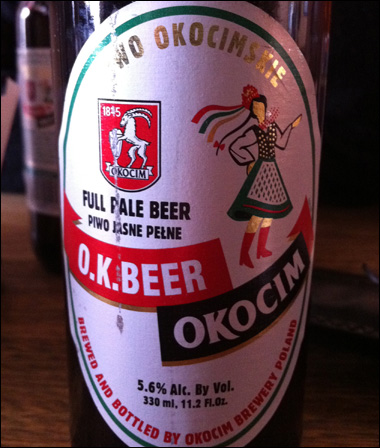
Today’s Lesson in Understatement comes to you from Poland.
Sun 9 Oct 2011
Posted by anaglyph under Food & Drink
[9] Comments

Mon 3 Oct 2011
Posted by anaglyph under Food & Drink, Food Science, Hokum, In The News, Silly, Skeptical Thinking, WooWoo
[21] Comments
Ah, dear Cowpokes. If there’s one thing that remains completely reliable in the World of Woo, it’s that people will relentlessly find ways to re-invent, repackage and re-market good ol’ H20 as some kind of miracle product. For your delectation this morning, I present to you the following newspaper snippet that comes to you courtesy of the Weekend Australian and my fellow tweeps ((You see how I’m actually warming to Twitter, don’t you now?)) @johncarneyau & @DrRachie.
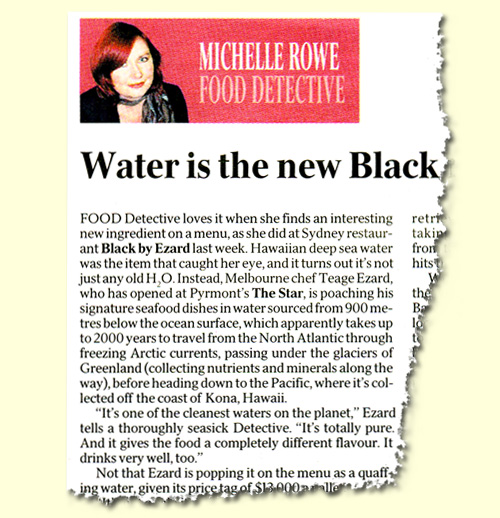
It is to laugh. Now, I have not dined in chef Teage Ezard’s restaurant ((I have food allergy: I’m allergic to anything that contains hogwash. It causes me to launch into long raves about how stupid people can be. Ask Violet Towne. She’ll tell you.)) but when I read something like this:
It’s one of the cleanest waters on the planet. It’s totally pure. And it gives the food a completely different flavour.
…I already know, without the need to do any further research, that the person saying it is a nitwit. Understand this, Mr Ezard: it’s not hard to make ‘totally pure’ or ‘clean’ water. Millions and millions of litres of it are created every day for one use or another. It’s done very simply: you boil it and condense it, or you filter it. THAT. IS. ALL.
But of course for block-headed pretentious chefs-de-cuisine and air-headed credulous journalist gourmands, that’s WAY too prosaic. They don’t want ‘pure’ water, they want magic water – ‘2000 year old’ magic water from the bottom of the ocean, in this case.
Whoa, hang on there Faithful Acowlytes – no need to bang the tin cups on the bars. Yes, water from the ocean IS salty, even if it is old. So how can it be ‘pure’? Well, to answer that question we must visit the source of Chef Ezard’s mystical water, ‘the island paradise of Hawaii’ and consult the makers of the product in question: MaHaLo Hawaii Deep Sea Water.
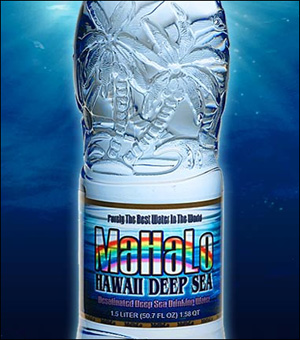
[Cue Hawaiian guitars and hula dancers]
MaHaLo Hawaii Deep Sea drinking water comes to you from the island paradise of Hawaii, 3,000 feet below the ocean’s surface, where the water is naturally clean, pure, cold and filled with healthy minerals and nutrients.
Aha! Naturally clean, pure, cold and filled with healthy minerals! Righty-ho, that’s easy – nothing left to do but bung it in some bottles and ship it to the customers!
Koyo USA Corp. pumps the water into its ultra-modern processing facility, where it removes the excess sea salt and tests it for purity and content.
Wha? They have a processing facility? And they need to remove stuff? And then do tests? So when they told us before that their water is naturally clean and pure, they meant, ‘kinda sorta’, it seems.
Deep Sea Water contains abundant amounts of essential minerals like potassium, calcium and selenium, plus minute amounts of many of the trace elements such as iron, copper, zinc, manganese and chromium, which are missing from common surface water.
Maybe that’s so, but that’s not what’s getting into the bottle, is it? ((And what’s with the ‘common’ surface water?)) What MaHaLo is asking us to believe here is that they treat water in such a way that they can remove the sea salt, make the water ‘pure’ and still maintain its supposed magical balance of minerals. I’m highly skeptical of this. What I reckon happens in the MaHaLo plant is that they desalinate the water, measure its characteristics, and then add stuff back to it. This is not rocket science, nor is it particularly special – it happens in water bottling plants all over the planet.
These trace minerals help humans absorb the vitamins in food and pass these directly into the system.
Actually (and I’m prepared to stand corrected on this matter) I was under the impression that it’s vitamins that help the body absorb metals and minerals and not the other way around. Whatever the case, it’s plain bunk that you need to get necessary trace minerals from drinking water; whatever you need you can get from a healthy diet.
In some cases, bottled water marketed as “natural spring water†with pictures of mountain streams and lakes on the bottles’ labels is nothing more than filtered tap water.
That’s right. And in some other cases, bottled water marketed as “natural deep sea water”, with pictures of palm trees and rainbows on the bottles’ label is nothing more than filtered sea water.
We at Koyo USA take these deceptive claims very seriously and strive to meet and exceed EPA and FDA standards for our water.
The implication here is that there is something rare or special about meeting or exceeding EPA and FDA water quality requirements – this is a wondrous use of weasel language. ALL bottled water and even normal tap water is required to meet those standards. MaHaLo should be doing more than striving – they should be guaranteeing!
There is no healthier way to obtain all the nutrition your body requires from water than MaHaLo Hawaii Deep Sea® Water.
Nutrition? Really? Er… actually, your body doesn’t require any nutrition at all from water. I think they’re getting confused with food. What your body requires from water is water. Counting on water to provide nutrition is almost as dumb as counting on air to provide nutrition.
But perhaps I have this whole affair arse-about. Maybe that’s what Teage Ezard is getting at with his fancy boil-in-a-bag haute cuisine: there’s no nutrition in the food itself, so he’s hoping you’ll get it out of the water! It’s at least as plausible as claiming that it makes the food taste any different. I guess Chef Ezard feels compelled to do something flamboyant with MaHaLo Deep Sea Water: for the $13,000 per pallet that they apparently charge for it, you’d certainly not be wanting to piss the stuff away. ((MaHaLo is certainly not spending any of their profits on their advertising. The commercial on their home page is one of the lamest, crummiest, least-persuasive ads I’ve ever seen. And I’ve seen some.))
[More silly water stories here, here, here (bonus material in Comments), here and here.]
Thu 15 Sep 2011
Posted by anaglyph under Atheism, Food & Drink, Plants, Religion, Skeptical Thinking, The Baffling Bible
[51] Comments
Tetherd Cow Ahead Presents: The Baffling Bible
Episode #5: Jesus and the Fig Tree
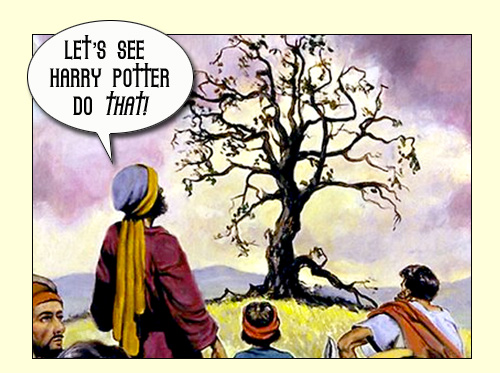
When I was a kid in Sunday School, I learned lots about the life of Jesus. I knew the stories of the Sermon on the Mount, the casting out of demons into swine, the miracle of the loaves & fishes, the overturning of the moneylenders’ tables in the tabernacle and many other colourful yarns that have turned out to have about as much relevance to my adult life as they did to my ten-year-old self.
One baffling tale that doesn’t usually get much of an airing when the life of Our Lord is being recounted, though, is the story of Jesus and the Fig Tree. It certainly didn’t make it into my Bible class back in the day – I think it’s just possible that’s because a ten-year-old might’ve empathized with it all too well.
To set the the scene: Jesus has returned from his 40 days and nights in the desert where he has had a lengthy hobnob with God, and is traipsing across the countryside accumulating crowds ((We should take mentions of ‘crowds’ in the Bible with a grain of salt. That part of the world was not especially densely populated at that time, and I suspect that if you got a toothless man and his wife and their goat to come out and look at you, that probably counted as a ‘crowd’. Especially in the eyes of someone spinning a yarn to beat up some PR, as Matt and Mark unquestionably are.)) of the faithful and assembling the cabal of chaps who would end up as his apostles. This is the Jesus of Matthew and Mark. This is the Jesus we all know and love from the comic books; he has just appeared to his followers (and Matthew & Mark’s readers) in dazzling white raiment which of course proves he is not just some guy like all the other common-garden-variety Messiahs who were touring the land at the time. In addition, he takes every opportunity to voice noble (if mostly obvious and occasionally curious) moral advice, and he performs miracles. Lots of them. ((I feel I have to point out that, in the light of the way we are familiar with ‘healings’ & clairvoyance and visions of the Virgin and other contemporary ‘miracles’, you don’t have to try too hard to come up with fairly reasonable non-supernatural explanations for all Jesus’ marvellous conjurations. And given nearly 20 centuries of undoubted ’embroidery’, well…))
The Story of the Fig Tree is one such miracle. We’ll take up the tale with Jesus waking up one morning after having spent the night in the countryside outside Jerusalem (somewhere around here I figure). Over to Matthew to relate the tale in his compelling literary style:
Now in the morning as he returned into the city, he hungered.
And when he saw a fig tree in the way, he came to it, and found nothing thereon, but leaves only, and said unto it, Let no fruit grow on thee henceforward for ever. And presently the fig tree withered away.
And when the disciples saw it, they marvelled, saying, How soon is the fig tree withered away!
~(Matthew 21:19)
In other words, because Jesus was hungry and there were no figs, he threw a tantrum and did the supernatural equivalent of punching his fist through the wall: he put a curse on the tree. Kapow! Take THAT you stupid tree! I’ll teach you not to have figs out of season!
Now religious scholars are quick to put forward all kinds of explanations for this decidedly tetchy Saviour behaviour. It’s certainly not fashionable these days to have Jesus to appear to petulantly invoke his super powers out of spite, so most modern Christian scholars interpret the story of Jesus and the Fig Tree as some kind of metaphorical statement about the condition and the predicted eventual fate of the Jewish nation.
But I want you to pause and reflect on that for a moment. None of Jesus’ other miracles get the ‘allegory’ explanation. If Jesus does a really cool thing – like healing a blind man, say, or walking across a lake – that’s not a metaphor. That’s a myrrh-soaked, gold-plated, frankinsence-doused, cross-my-heart-and-hope-to-die-and-never-be-resurrected MIRACLE! But when Our Lord chucks a tanty and fries a fig tree, well then, that must be symbolic…
That’s all well and good, and I might even buy it except for one thing: both Matthew and Mark independently make the effort to point out that Jesus was hungry. This tiny detail makes nonsense of the fall-of-the-Jewish-nation explanation. How does that high-falutin’ symbolism have anything to do with Jesus not getting breakfast? Plus, it just gives the whole story a ring of truth – I mean, we’ve all been there, right?
No, Faithful Acowlytes, I believe that the most reasonable hypothesis for this story is that Jesus just got out of bed on the wrong side and took his grumpiness out on the first thing he saw (and I offer this as scientific endorsement of my assertion). Luckily it was just a tree – his dad had something of a tendency to take his pique out on entire cities.
Or maybe, just maybe, the Westboro Baptist Church has had it right all along, only their bibles have a small typographical error…

Mon 15 Aug 2011
Posted by anaglyph under Food & Drink, Hokum, Insane People, Skeptical Thinking, True Fiction
[24] Comments
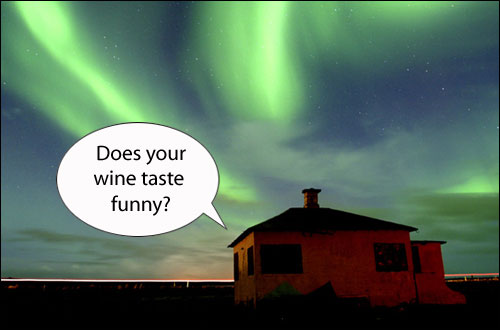
Today I’m going to try something new. I’m going to INVENT some kind of crazy new pseudoscientific idea and try and get people to believe it. First of all, I’m going to pick a field of interest that has some high levels of subjectivity. OK, um… – oh I know, wine tasting! There’s all sorts of hocus pocus goes on with that. Now let’s see… I’ve got it! You know when people swish the wine around in the glass? Could it be that swishing it clockwise makes it taste different to swishing it anticlockwise? You know: clockwise swirling brings out the spicy notes and anti-clockwise makes it taste more of the fruit. Genius! I’ll call it ‘wine swirling’ and…
Sorry? What’s that you say? It already exists? People actually already believe it? Come ON! That’s ridiculous! No-one could seriously come up with such a patently silly notion…!
Yes, my dear Acowlytes, it is true. Faithful Cowpoke JR points me to this article from the owner of a tour company in the Napa Valley in California, that espouses the fine art of wine swirling. This is what Mr Ralph de Amicis, of Amicis Tours has to say:
This idea starting circulating around Napa via Twitter and here it is in a nutshell. When you swirl your wine to the left (counter clockwise) the scent you pick up is from the barrels over the grapes, what we call the spice shelf. When you swirl the wines to the right (clockwise) you pick up more flavors from the fruit.
O-k-a-a-a-y…. The idea started on Twitter, that completely reliable repository of fact and commonsense. That speaks volumes. Mr de Amicis goes on:
I’ve shown this to clients in the tasting room and experimented with it myself and found it to be true, and especially noticeable with wines that have spent significant time in newer oak barrels. The question comes up, why is that?
Well, Mr de Amicis, the answer comes back pretty smartly: you’re deluding yourself. But don’t, for God’s sake, attempt any kind of explanation because you’ll only…
Like all living things wine cells have a magnetic polarity, just like humans and the Earth. The positive pole is more highly charged, just like the North Pole of the Earth, which is why there are Northern Lights in the Arctic Circle, but not Southern Lights in the Antarctic. This polarity tends to keep wine cells generally upright, spinning on their axis when they are being swirled…
Awww…dagnabbit!! I was feeling like cutting you a little slack but then you went and did some pretendy science on me. Sigh.
I guess by now about, oh, every person who lives in the Southern hemisphere has told you that there is, in fact, an Aurora Australis, which is exactly the same as the Aurora Borealis only on the other pole. Your failure to know this, and the cavalier attempt to base a line of reasoning on it, kinda nails your scientific credentials to the mast right there. ((If Mr Amicis had taken a few seconds to make a cursory check on Wikipedia he might have seen this: ‘Its southern counterpart, the aurora australis (or the southern lights), has almost identical features to the aurora borealis and changes simultaneously with changes in the northern auroral zone.’))
When you swirl the wine counter-clockwise you are pushing against the molecules nap, just like stroking the fur of a cat the wrong way, this dislodges anything on the surface. Since the flavor from the barrel is introduced fairly late in the wine’s development it tends to concentrate in the outer layers. When you swirl the wine counter-clockwise it dislodges that flavor, while at the same, pushing liquid into the pores, inhibiting the fruit flavors that are inside the cell from coming out.
Molecules have nap? ‘Flavor’ is on the ‘surface’ of the molecules and can be ‘dislodged? Molecules have pores? ‘Liquid’ goes into the ‘pores’ of the cells? Molecules? What? Ping! Now let’s be honest Mr de Amicis. You just made all that crap up, didn’t you? Like you made up the non-existence of the Southern Lights. You haven’t the foggiest clue how taste and smell work, have you? (You don’t hold shares in Special One Drop Liquid, by any chance? Or study under Dr Werner?)
Evidently I wasn’t the only one who found Mr de Amicis’s ‘science’ risible, as he was quick to post a justification of his views on his site. In this, he makes much of his scientific qualifications:
I’ve written eight books on wine country, three books on natural health, I’m a Master Herbalist with forty years of experience working with plants and people, a Naturopathic Physician, and I’ve lectured extensively on anatomy and physiology.
Right, so no actual science accreditation, then? ((Lecturing on something does not count as academic endorsement. I could ‘lecture’ on brain surgery, but it doesn’t mean I know anything at all about it.)) And nothing there about geomagnetic science, molecular chemistry or physics, which does explain rather a lot. Not content with just riding the faux pas out, though, our knowledgeable tour guide just keeps on digging…
Everything has a polarity right down to the atomic level, and when put into suspension in a liquid it rotates in relation to that pole. Because we are on a planet that has both a polar system and a consistent rotation, everything forms with a pole and a circular patterning. Wind it one way and it tightens and wind it the other and it unwinds.
Uh. That’s what you learnt in herbal school, is it? Or in naturopathy college? Because they sure as hell don’t teach it in any science class I’ve ever been in. ((Mr de Amicis’s view of the planet is, evidently, that it functions like it’s powered by a giant rubber band.))
Honestly this is just basic physics related to molecular science and plant chemistry, something which herbalists and herbal researchers deal with all the time.
Honestly! Basic physics! Like the non-existence of the Aurora Australis due to the polarity of the Earth! ((Anyone with even an ounce of geophysical knowledge knows that the auroras don’t have anything at all to do with the positive or negative polarity of the the planet, but appear at the poles due to the shape of the Earth’s magnetic field and its focussing effect.))
By the way, I’ve done an informal study of this and my hyper-sensitive clients all notice the difference in the swirl directions and the nature of the scents. I would love to hear other people’s theories about this,
And I would love to oblige!
What’s going on here, Mr Amicis, is that your brain is tricking you. Because you have sold yourself on this daft idea, and because wine tasting is full of subjective assessments, you (and your ‘hyper-sensitive clients’) merely think that you’re detecting an effect. In proper science (that is, the kind that they don’t teach in naturopathy school) we have a way of eliminating this problem of self-delusion. It’s called ‘double blinding’ and I’m fairly sure ((When I say ‘fairly sure’ I am just being linguistically coy. I am in fact 100% certain.)) that if you had an unbiased third party set up a double blind testing of your idea you’d find that the ‘swirling factor’ mysteriously vanishes. I’m not going to explain double blinding here on the Cow for the millionth time, but I really do suggest you look it up on Wikipedia and familiarize yourself with the concept before you go making a further fool of yourself. You should probably read up on the auroras and the magnetosphere as well. Just saying.
The moral to this story, if it’s not obvious, is that if you want to promote something as science, make sure you understand what science is. Especially if you decide to write about it on your web site where the whole world can see it.
Thu 16 Jun 2011
Posted by anaglyph under Australiana, Food & Drink, Nostalgia
[9] Comments
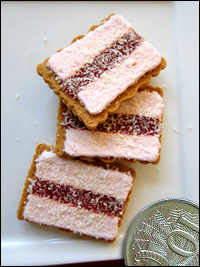
When I was a kid, the best treat you could possibly be offered was a pick from a plate of Iced Vovos. The Iced Vovo is a confection completely native to Australia, and, as far as I’m aware, has never spread beyond these shores. The Iced Vovo consists a biscuit crust overlaid with pink fondant ((NOT marshmallow – that was an entirely different treat, and, in my opinion, a rather more predictable one.)) which is bisected by a strip of raspberry jam. It is my memory that the Iced Vovo was a lot bigger when I was a kid, and has now sort of shrunk to a much less generous-sized item. I have asked numerous people about this, and everyone seems to be in agreement. It’s one of those things that’s rather hard to substantiate of course, there being no ancient Vovos still in existence. I do hold the fond hope that someone, somewhere in the 1960s thought to take a photograph of an Iced Vovo with a ruler for scale.
Thu 19 May 2011
Posted by anaglyph under Australiana, Food & Drink, Food Science, In The News
[16] Comments
I’m not one for patriotism. In this rapidly shrinking world I feel that the idea of ‘belonging’ to one country or another is as silly as forever waving a flag for the town where you were born ((Goulburn, NSW.)) But sometimes, sometimes, along comes an event that makes me truly proud to be Australian.
This morning I read in the Guardian of one such event. Ladies and gentlemen, allow me to announce to you, direct from Australia … Space Beer.
That’s right friends, the 4 Pines Brewing Company in Sydney, Australia, is proposing to go where no brewery has gone before by concocting a malty beverage fit for astronauts.
Humanity loves beer. We always have and always will. The Space tourism market is emerging and will take off in less than 2-years, with thousands of screaming, happy space fans booked on suborbital flights. Guaranteed some of them will want the option to enjoy a brew while looking at our big Blue Globe. Why deny them the chance?
Why indeed?! To this end, Jaron Mitchell and Jason Held from 4 Pines have developed their Vostok 4 Pines Stout, which, like good scientists, they have tested under the conditions in which it will be consumed.
A microgravity expert from the non-profit organization Astronauts4Hire (A4H) provided the test subject. The tester, who also works part-time as an in-flight coach for ZERO-G, had over 300 parabolas in microgravity. The tester consumed nearly 1-litre of the beer during weightless portions of the flight, while recording basic biometric data to track effects of the experiment.
This obviously gives the ‘vomit comet’ a whole new level of potential.
Making a brew suitable for consumption in zero gravity is not all beer & skittles though. There are a few obstacles to be overcome:
Beer aficionados will notice two differences when drinking in space. First, the sense of taste is reduced due to mild swelling of the tongue. Second, drinking beers can be uncomfortable—bubbles do not rise to the top, because there is no “top†in space. Gasses and liquids don’t like to separate. So if you have to burp, you will burp both beer and bubbles.
Hmmm. Beer-bubble-burps. Not something you might like to inflict on that groovy zero-g chick you have your eye on.
Undaunted, 4 Pines has pushed on to address these problems by re-engineering one of their previous award-winning beers to create the new highly-flavoured space stout.
This is not a “novelty beer†with the same bland taste as your normal stuff. This is a craft beer. It is meant first for people who love beer so it MUST TASTE SUPERB on Earth.
Of course you don’t need wait for your Virgin Galactic flight to sample Vostok 4 Pines – it’s already available Earthside. But only for Australians. Sorry foreign folks: that’s one of the perks you get for living in a country of innovation! ((I may have to acquire a few bottles and report back…))
